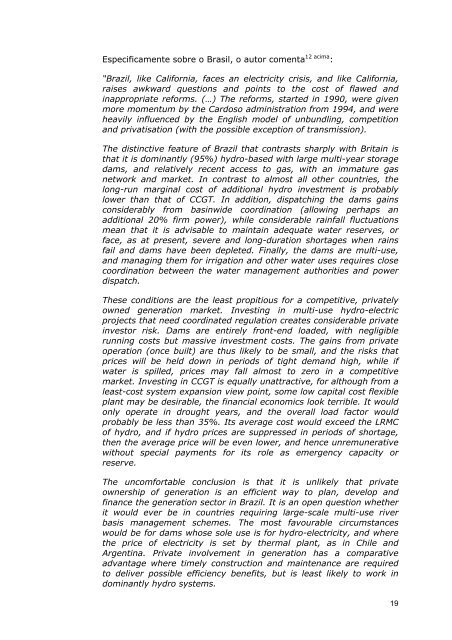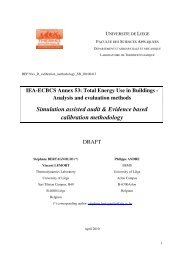Um Novo Modelo para o Setor Elétrico Brasileiro
Um Novo Modelo para o Setor Elétrico Brasileiro
Um Novo Modelo para o Setor Elétrico Brasileiro
Create successful ePaper yourself
Turn your PDF publications into a flip-book with our unique Google optimized e-Paper software.
Especificamente sobre o Brasil, o autor comenta 12 acima :<br />
“Brazil, like California, faces an electricity crisis, and like California,<br />
raises awkward questions and points to the cost of flawed and<br />
inappropriate reforms. (…) The reforms, started in 1990, were given<br />
more momentum by the Cardoso administration from 1994, and were<br />
heavily influenced by the English model of unbundling, competition<br />
and privatisation (with the possible exception of transmission).<br />
The distinctive feature of Brazil that contrasts sharply with Britain is<br />
that it is dominantly (95%) hydro-based with large multi-year storage<br />
dams, and relatively recent access to gas, with an immature gas<br />
network and market. In contrast to almost all other countries, the<br />
long-run marginal cost of additional hydro investment is probably<br />
lower than that of CCGT. In addition, dispatching the dams gains<br />
considerably from basinwide coordination (allowing perhaps an<br />
additional 20% firm power), while considerable rainfall fluctuations<br />
mean that it is advisable to maintain adequate water reserves, or<br />
face, as at present, severe and long-duration shortages when rains<br />
fail and dams have been depleted. Finally, the dams are multi-use,<br />
and managing them for irrigation and other water uses requires close<br />
coordination between the water management authorities and power<br />
dispatch.<br />
These conditions are the least propitious for a competitive, privately<br />
owned generation market. Investing in multi-use hydro-electric<br />
projects that need coordinated regulation creates considerable private<br />
investor risk. Dams are entirely front-end loaded, with negligible<br />
running costs but massive investment costs. The gains from private<br />
operation (once built) are thus likely to be small, and the risks that<br />
prices will be held down in periods of tight demand high, while if<br />
water is spilled, prices may fall almost to zero in a competitive<br />
market. Investing in CCGT is equally unattractive, for although from a<br />
least-cost system expansion view point, some low capital cost flexible<br />
plant may be desirable, the financial economics look terrible. It would<br />
only operate in drought years, and the overall load factor would<br />
probably be less than 35%. Its average cost would exceed the LRMC<br />
of hydro, and if hydro prices are suppressed in periods of shortage,<br />
then the average price will be even lower, and hence unremunerative<br />
without special payments for its role as emergency capacity or<br />
reserve.<br />
The uncomfortable conclusion is that it is unlikely that private<br />
ownership of generation is an efficient way to plan, develop and<br />
finance the generation sector in Brazil. It is an open question whether<br />
it would ever be in countries requiring large-scale multi-use river<br />
basis management schemes. The most favourable circumstances<br />
would be for dams whose sole use is for hydro-electricity, and where<br />
the price of electricity is set by thermal plant, as in Chile and<br />
Argentina. Private involvement in generation has a com<strong>para</strong>tive<br />
advantage where timely construction and maintenance are required<br />
to deliver possible efficiency benefits, but is least likely to work in<br />
dominantly hydro systems.<br />
19

















